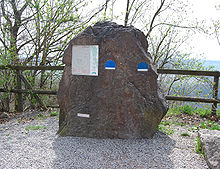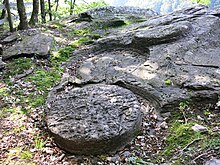Verrucano

Verrucano (also Alpine Verrucano ) is a series of rocks from the Permian of the Alps and the Apennines, as well as neighboring Alpine folds, characterized by conglomerates deposited on the continent . In addition to siliciclastic sedimentary rocks , the sequence also contains rocks of volcanic origin . The sometimes weakly metamorphic Verrucano is generally considered to be the counterpart of the Rotliegend rocks north of the Alpine region.
Concept and history
The first detailed scientific description comes from the year 1892 by Ludwig Milch ( Contribution to the knowledge of Verrucano ). However, Horace-Bénédict de Saussure already took notice of these rocks in the Alpine region through outcrops near Vallorcine and described them as Poudingues de Vallorsine in 1779, 1786 and 1796 . Ludwig Milch ascribes the coining of the term Verrucano to the Italian Paolo Savi , who examined these rocks on the island of Elba and at Castell Verruca in the Monti Pisani . In 1832 he named her under this name on a card and in a letter referring to ( Breccia da Macine del Targioni ) the naturalist Giovanni Targioni Tozzetti (according to another opinion, not until 1838).
A little later, in 1850, Bernhard Studer transferred this term, which was coined in Tuscany, to analogous rock sequences in the Swiss Alps.
description
The sedimentary rocks of Verrucano vary in color and appearance due to changing proportions of slate fragments , feldspar rubble and sericite binding agent. In addition to the characteristic conglomerates and breccias , the Verrucano series of layers contains sand , silt and clay stones . In some places there are stronger metamorphic zones in the form of mica-slate-like and gneiss- like forms. The color of the rocks is often red, subordinate to green, purple or gray-brown. Included in the sediment sequence are volcanic deposits, partly as lava or ash layers, partly as volcanic passages .
The sediment sequence formed in rivers and seasonal torrents as a deposit of the weathering products of the Variscan mountains . By weathering and oxidation of the iron sediment obtained a red color. The oxidation of the sediment also proves that a hot climate must have prevailed during the period of deposition, as was the case in the previous Upper Carboniferous . The formation and deposition method of the Alpine Verrucano assign it to the mainland Rotliegend deposition area, which was spread over large parts of Central Europe. Well-preserved and only slightly metamorphic sediments of Verrucano can be found as thick deposits, especially in the Helvetic Alps. In the Penninic and Eastern Alps ( Northern Limestone Alps , Central Eastern Alps ) rocks of the Verrucano are also known (up to Permoskyth , Wende Perm / Lower Triassic), but here they were more closely involved in the Alpine mountain formation and are metamorphic.
Verrucano conglomerate by Collonges
Fountain made from Verrucano boulders in Zollikon
Millstone, former Werdmühle, Zurich
Natural stone
- Rouge de Collonges , near Collonges
- Vert de Salvan , at Salvan
- Melserstein , near Mels with a millstone quarry
literature
- F. de Quervain: The usable rocks of Switzerland . Kümmerly & Frey, Bern 1969.
- Toni P. Labhart: Geology of Switzerland . Ott Verlag, Thun 2001, ISBN 3-7225-6760-2 .
Web links
Individual evidence
- ↑ Marco Tongiorgi: Gli Studi geologici sui Monti Pisani . (University of Pisa) Retrieved May 17, 2010
- ^ Ludwig Milch: Contributions to the knowledge of Verrucano . Wroclaw 1892
- ↑ FC Marmocchi: Descrizione dell 'Italia . Firenze 1846, pp. 156-157
- ↑ Paolo Savi: Lettera al Signore girolamo Guidoni di Massa concernente osservazioni geognostiche sui terreni antichi toscani, concernenti specialmente i Monti Pisani, le Alpi Apuane e la Lunigiana . In: Nuovo Giornale dei Letterati, 24, 1832. pp. 202-217.
- ^ [1] Lettera del Prof. Paolo Savi al sig. Girolamo Guidoni di Massa. Pisa 1832
- ↑ Detailed information on the Alpine Verrucano from loccata, accessed April 25, 2010
- ↑ Peter Faupl: Historical Geology: An Introduction . ( P. 107f in the Google Book search).




